What Is Time Blocking?
If you’ve ever felt like your to-do list is running your life instead of the other way around, welcome to the club. The good news? There’s a strategy that might just flip the script—time blocking. It’s like giving your day a makeover, breaking it into clear, focused chunks instead of letting it spiral into a chaotic free-for-all. Let’s dive into what time blocking is, how it works, and how it stacks up against other productivity methods.
What Is Time Blocking, Exactly?
Imagine your calendar as a giant puzzle, and each piece represents a task or activity. Time blocking is all about assigning each piece a specific spot on the board. Instead of writing down “reply to emails” and “finish presentation” on a generic list, you’d carve out 30 minutes for emails and, say, an hour for your presentation.
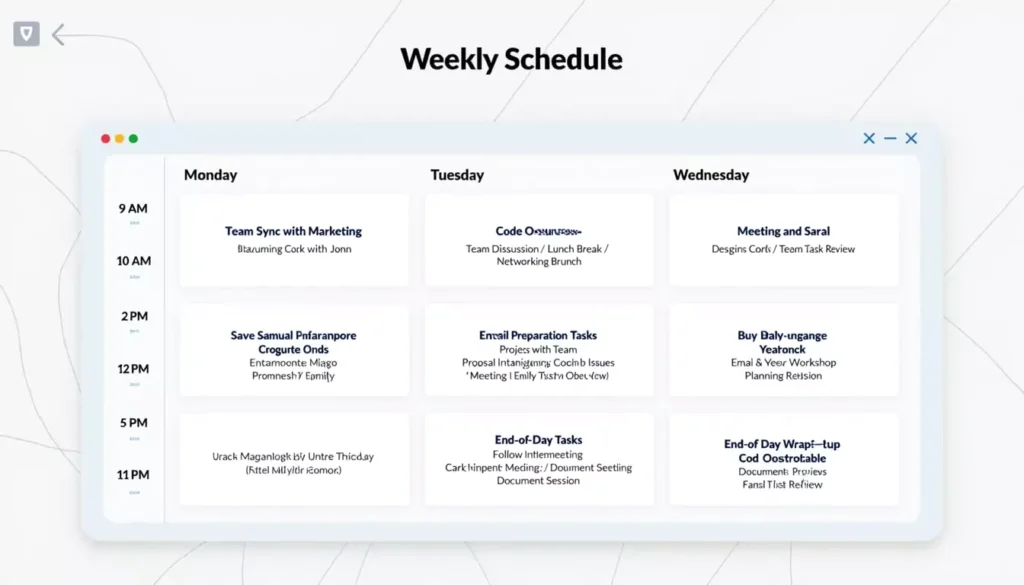
It’s not just about planning your day—it’s about designing it. Think of it as putting your to-do list directly into your calendar. You’re creating a roadmap for your time, so every hour has a purpose. And yes, that includes setting aside time for breaks, lunch, and—gasp—even a Netflix binge if that’s what you need.
How Does It Work?
Here’s how you can get started with time blocking in a way that feels natural:

- Brain Dump Your Tasks: Write down everything you need to get done. No filter—just let it all out.
- Prioritize Like a Pro: Identify what’s urgent, what’s important, and what can wait.
- Block Your Calendar: Open your calendar app (or grab a planner if you’re old-school) and assign time slots to each task.
- Be Realistic: Overpacking your day is like trying to stuff a suitcase—something’s going to spill out. Leave buffer time between blocks for unexpected stuff.
- Stick to the Plan: Treat your calendar like it’s set in stone. When it’s email time, do emails—not TikTok scrolling.
A practical example: Say you’re working on a report. Instead of vaguely planning to “work on the report today,” you might schedule:
- 9:00 AM – 9:30 AM: Research
- 9:30 AM – 10:00 AM: Outline
- 10:00 AM – 11:00 AM: Draft
Why Does Time Blocking Work So Well?
Time blocking is like a GPS for your brain. It takes the guesswork out of your day, reducing decision fatigue and helping you focus on one thing at a time. According to a study published in Psychological Review, switching between tasks can slash your productivity by as much as 40%. Ouch. Time blocking minimizes this by keeping you locked into one task per block.

It’s also great for tackling procrastination. When your calendar says “3:00 PM: Write blog post,” there’s less wiggle room to put it off. Plus, let’s face it—crossing something off a to-do list is satisfying, but knowing you stuck to a schedule? That’s next-level rewarding.
How Is It Different From Other Productivity Methods?
Here’s how time blocking compares to a few popular strategies:
- Time Boxing: Time boxing is a cousin of time blocking. Instead of scheduling an entire task, you assign a fixed amount of time to work on it—even if you don’t finish. For example, you might say, “I’ll spend one hour on emails,” and stop when the hour is up. It’s great for setting boundaries, but it’s less structured than time blocking.
- Task Batching: This involves grouping similar tasks and tackling them together. For instance, you might dedicate one block to answering all your emails and another to making phone calls. It pairs beautifully with time blocking because you can batch tasks and block time for them in your calendar.
- Day Theming: With day theming, you assign a specific focus to each day. For example, Monday might be for meetings, Tuesday for creative work, and so on. While it works well for people with repetitive schedules, it’s less flexible than time blocking.
Think of time blocking as the Swiss Army knife of productivity—it combines the best of these methods into one system.
Expert Opinions and Data to Back It Up
Productivity guru Cal Newport, author of Deep Work, swears by time blocking. He argues that it helps you reclaim your day from endless interruptions and low-value tasks. And he’s not alone. Research from the Journal of Experimental Psychology shows that structured schedules can improve focus and reduce stress.
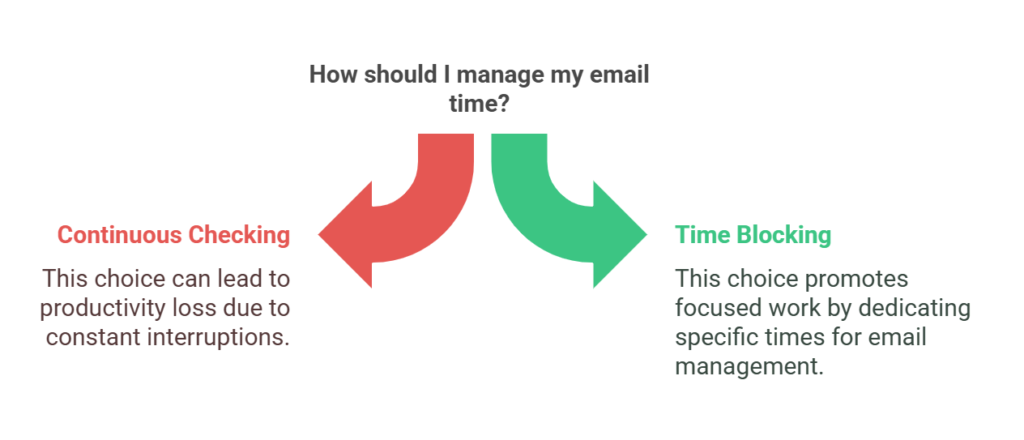
In numbers: A survey by RescueTime found that 26% of people spend three to four hours daily just checking their email. Time blocking can help cut that down dramatically by setting aside a dedicated window for emails instead of letting them hijack your entire day.
Why Is Time Blocking So Great for Staying Organized?
You ever have one of those days where you’re running around trying to do everything, and by the end of it, you can’t even remember what you actually got done? Same. That’s where time blocking steps in. It’s like the cheat code for keeping your day on track and your mind in check. Let’s talk about why it works so well—and why it’ll totally make your life easier.
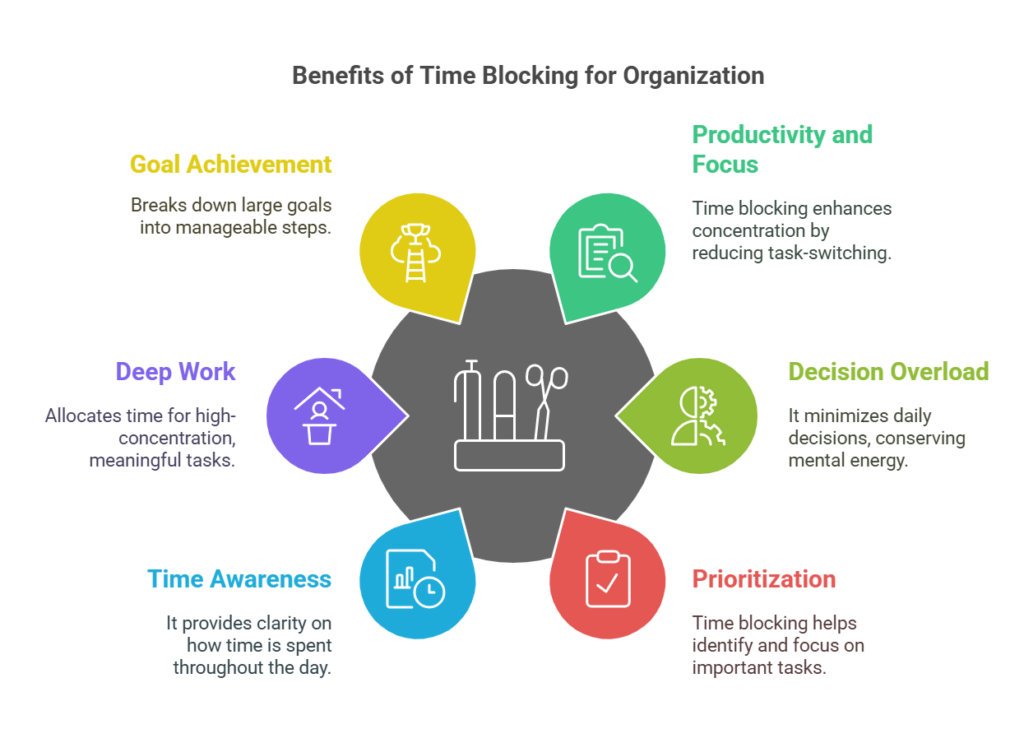
It Boosts Productivity and Focus
Here’s the thing: when your day is all over the place, it’s hard to actually focus on anything. Did you know it takes around 23 minutes to refocus after you’ve been interrupted? (Yep, someone actually studied this.) Time blocking cuts out the chaos by giving each task its own little space. You’re not flipping back and forth between emails, texts, and whatever else pops up—you’re just doing one thing at a time.
For example, instead of trying to “write the report” while also keeping an eye on Slack, you block out 10:00 AM to 11:00 AM to work on the report—and nothing else. Suddenly, what felt like a mountain doesn’t seem so bad because you’re actually focused.
It Saves Your Brain From Decision Overload
Have you ever spent more time deciding what to do than actually doing it? Same. Apparently, we make around 35,000 decisions a day (crazy, right?), and all that back-and-forth eats up your energy. Time blocking simplifies it: your day is already planned out, so you don’t have to keep asking, “What should I do next?”
And let’s not even talk about multitasking. It’s a productivity killer. Studies say it makes you 40% less efficient. With time blocking, you’re like, “Okay, it’s email time,” or “Now it’s project time,” and you’re all in. No split focus, no wasted energy.
It Helps You Sort Out What Actually Matters
We all have those days where the to-do list feels like it’s never-ending, right? Time blocking forces you to figure out what’s actually important. You’re not just jotting down “work on presentation” and hoping it somehow gets done—you’re breaking it into smaller chunks like:
- 9:00 AM to 9:30 AM: Research ideas
- 9:30 AM to 10:00 AM: Create the outline
- 10:00 AM to 11:00 AM: Design the slides
This way, even the big stuff feels manageable. And bonus: you’re way less likely to end up staring at your list thinking, “Where do I even start?”
It Shows You Where Your Time Actually Goes
Ever get to the end of the day and wonder where all your time went? Time blocking is like holding up a mirror to your schedule. By planning out your day in advance, you start to see things like, “Wow, I spent two hours on emails when it could’ve been 30 minutes.”
You can even color-code your blocks if you’re feeling fancy: blue for meetings, green for deep work, yellow for personal stuff. It’s like a quick visual check to see if your day is balanced or if you’re spending way too much time on things that don’t matter.
It Gives You Room for Real Work (Not Just Busy Work)
Here’s the deal: not all work is created equal. The important stuff—the kind that actually moves the needle—takes focus. That’s what Cal Newport calls “deep work.” But if you’re constantly putting out fires or stuck in admin tasks, when do you find time for that?
With time blocking, you set aside actual chunks of time for deep work. Maybe 9:00 AM to 11:00 AM is your time to crush that big project. And then you save the shallow work—emails, scheduling, all that—for a smaller block later in the day. It’s about giving the right tasks the right amount of attention.
It Turns Big Goals Into Actual Plans
We all have goals that feel a little…intimidating. Whether it’s learning a new skill, tackling a massive project, or just finally decluttering the garage, it’s hard to know where to start. Time blocking breaks those goals into small, doable steps.
Let’s say your goal is to learn how to play guitar. Instead of vaguely saying, “Practice guitar,” you’d block:
- Monday: 7:00 PM to 7:30 PM – Learn chords
- Wednesday: 7:00 PM to 7:30 PM – Practice strumming patterns
- Friday: 7:00 PM to 7:30 PM – Play a simple song
Suddenly, that big, scary goal looks a lot more manageable. And because it’s on your calendar, it actually happens.
How to Start Time Blocking to Stay Organized
You know those days when everything feels like it’s coming at you from all angles, and by the end of it, you’re like, “What did I even get done?” Time blocking can fix that. It’s a simple way to organize your day so you know exactly what you’re doing and when. Let’s break it down step by step—super easy, no fancy tools required.
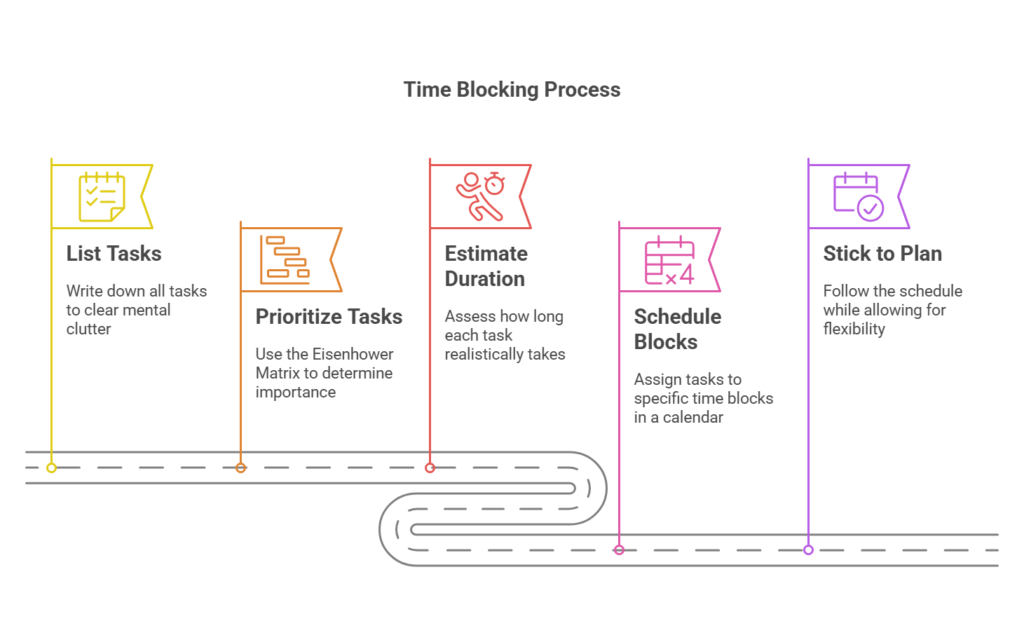
1. List Your Tasks
First things first: write down everything you need to do. Work stuff, errands, chores, even the little things like “call Mom” or “order dog food.” Get it all out of your head and onto a list. Think of this as clearing out the mental clutter so you can see what you’re actually working with.
2. Prioritize Your Tasks
Now that you’ve got your list, it’s time to figure out what’s really important. Here’s a trick: use the Eisenhower Matrix. It sounds fancy, but it’s basically just sorting tasks into four groups:
- Do it now: Important and urgent (like meeting a deadline).
- Schedule it: Important but not urgent (like working on a long-term goal).
- Delegate it: Urgent but not important (like replying to routine emails).
- Skip it: Not urgent or important (hello, Instagram scrolling).
This helps you focus on what actually matters instead of getting sucked into low-priority stuff.
3. Figure Out How Long Things Take
Be real with yourself here. How long does it actually take to finish a task? If writing a report always takes you two hours, don’t kid yourself and schedule it for 30 minutes. And if you’re not sure how long something takes, track it for a week. Apps like Toggl or even just a stopwatch on your phone can help.
4. Schedule Your Time Blocks
Here’s the fun part: plugging your tasks into your calendar. Open up your favorite calendar app (Google Calendar is a solid choice) and start assigning blocks of time to your tasks. For example:
- 8:30 AM – 9:00 AM: Morning emails
- 9:00 AM – 10:30 AM: Deep work (like writing or strategizing)
- 10:30 AM – 10:45 AM: Quick break
- 10:45 AM – 11:15 AM: Team meeting
- 11:15 AM – 12:00 PM: Organize project files
Color-coding your blocks can also help. For example, you might use blue for work tasks, green for personal stuff, and yellow for breaks. Seeing everything laid out visually makes it way easier to stay on top of your day.
5. Stick to the Plan (But Be Flexible)
This part’s key: once you’ve got your schedule, actually stick to it. Treat your time blocks like appointments. If your calendar says it’s time to work on a project, don’t get distracted by TikTok or random emails. But…life happens. If something urgent comes up, just adjust your blocks. The beauty of time blocking is that it’s flexible. It’s your schedule, so you can move things around as needed.
Time Blocking Methods to Stay Organized
Let’s face it: staying organized isn’t always easy. One minute you’re feeling on top of things, and the next, you’re buried under a pile of tasks wondering where your day went. That’s where time blocking comes in. It’s not just about being productive—it’s about making your day feel less chaotic and more manageable. Here are a few time-blocking methods to help you stay organized without losing your mind.
1. Task Batching: Grouping Similar Tasks Together
Ever feel like switching between tasks makes your brain feel scrambled? You’re not alone. Research shows that jumping between tasks can tank your productivity by up to 40%. That’s why task batching is such a lifesaver. The idea is simple: group similar tasks together and knock them out in one go.
Here’s how it might look:
- Instead of checking emails all day, set aside a block of time just for emails.
- Need to make calls? Do them all back-to-back.
- Got errands to run? Batch them so you’re not zigzagging all over town.
It’s like running your to-do list through a washing machine—everything gets handled more efficiently, and your brain doesn’t have to constantly shift gears.
2. Day Theming: Giving Each Day a Focus
If your week feels like a jumble of unrelated tasks, day theming might be your new best friend. It’s all about dedicating specific days to specific types of work. Think of it as giving your week some structure so you’re not juggling 10 different things every day.
Here’s an example:
- Monday: Meetings and planning
- Tuesday: Creative work like writing or designing
- Wednesday: Admin tasks (emails, reports, invoicing)
- Thursday: Big project work
- Friday: Catch-up or professional development
Jack Dorsey, the guy behind Twitter and Square, swears by this method. If he can stay organized running two companies, we can probably make it work for our lives too. Day theming keeps you focused and makes it easier to mentally prepare for the day ahead.
3. Time Boxing: Setting Fixed Time Limits for Tasks
You know that feeling when you spend way too long on something and wonder where the time went? Time boxing is here to save the day. The concept is simple: give yourself a set amount of time for a task, and when the time’s up, you’re done. No lingering, no perfectionism.
For example:
- Spend 30 minutes decluttering your desk. Even if it’s not perfect, you’ll make progress.
- Set an hour to draft a presentation—then refine it later if needed.
This works because of Parkinson’s Law, which says that work expands to fill the time you give it. By setting boundaries, you’re making sure tasks don’t take over your entire day.
4. Deep Work Blocks: Protecting Time for High-Focus Tasks
Deep work is where the magic happens. It’s that uninterrupted time when you can focus on something important without distractions. If you’re always getting pulled in different directions, scheduling deep work blocks can help.
Here’s how to do it:
- Block out 1-2 hours during your most productive time of day (for a lot of people, that’s the morning).
- Turn off notifications, close unnecessary tabs, and let people know you’re unavailable.
- Use this time for big, brain-heavy tasks like writing, planning, or problem-solving.
Even just one or two deep work blocks a day can make a huge difference in how organized you feel. Cal Newport, who literally wrote the book on Deep Work, says this kind of focus is what sets successful people apart.
How These Methods Work Together
The best part about these methods? You don’t have to pick just one. You can mix and match depending on what your week looks like. Here’s an example:
- Monday: Themed for meetings
- Tuesday Morning: Deep work block for a big project
- Tuesday Afternoon: Task batching for emails and admin work
- Wednesday: Time boxing to knock out smaller tasks
Color-code your calendar to keep things clear—blue for deep work, yellow for batching, red for meetings—and suddenly your week feels way more organized.
Time Blocking Examples to Stay Organized
Ever feel like your day is a giant puzzle with pieces scattered everywhere? That’s where time blocking comes in. It’s like putting the pieces together so everything fits neatly, and you actually feel in control. Whether you’re a busy professional, a student, or a freelancer, time blocking helps you stay organized and make the most of your day. Let’s look at some real-life examples to see how it works.
For Busy Professionals
If you’re juggling meetings, deadlines, and a never-ending stream of emails, time blocking can help you take back your day. Here’s a sample schedule:
| Time | Task | Notes |
|---|---|---|
| 7:30 AM | Morning routine | Coffee, news, plan the day |
| 8:00 AM | Emails and urgent replies | Get the inbox under control |
| 8:30 AM | Deep work (e.g., report writing) | High-focus tasks |
| 10:30 AM | Break | Step away from the screen |
| 10:45 AM | Team meeting | Collaborative time |
| 12:00 PM | Lunch | Recharge |
| 12:30 PM | Emails and follow-ups | Clear out the backlog |
| 1:00 PM | Deep work (e.g., strategy planning) | Focus time |
| 3:00 PM | Break | Quick reset |
| 3:15 PM | Calls and quick tasks | Handle smaller priorities |
| 4:00 PM | Wrap-up and plan tomorrow | Organize the next day |
Why It Works: You’re prioritizing deep work during your most productive hours and keeping email and meetings contained to specific slots. This way, you’re not constantly reacting to distractions.
For Students
Balancing classes, assignments, and maybe even a part-time job? Time blocking can keep your schedule from turning into chaos.
| Time | Task | Notes |
|---|---|---|
| 7:00 AM | Morning routine | Breakfast, plan the day |
| 7:30 AM | Study for exam | Focus on tough subjects |
| 8:30 AM | Commute to class | Use for light reading |
| 9:00 AM | Classes | Be present, take notes |
| 12:00 PM | Lunch | Recharge |
| 12:30 PM | Review notes | Go over class materials |
| 1:30 PM | Work on assignments | Deep focus time |
| 3:00 PM | Break | Grab coffee, relax |
| 3:30 PM | Library study session | High-focus environment |
| 5:00 PM | Part-time job or activities | Shift focus |
| 6:00 PM | Dinner | Relax and recharge |
| 7:00 PM | Light review or finish homework | Wrap up loose ends |
| 8:30 PM | Relax | Netflix or gaming |
Why It Works: By blocking out time for study, assignments, and even breaks, you’re avoiding last-minute cramming and giving yourself a balanced schedule.
For Freelancers
Freelancers often wear a lot of hats. Time blocking helps you stay on top of client work, admin tasks, and everything else you’ve got going on.
| Time | Task | Notes |
|---|---|---|
| 8:00 AM | Morning routine | Coffee, set priorities |
| 8:30 AM | Client communications | Emails, proposals, follow-ups |
| 9:30 AM | Project work (e.g., designing) | Deep focus time |
| 11:30 AM | Social media updates | Marketing tasks |
| 12:00 PM | Lunch | Recharge |
| 1:00 PM | Deep work (e.g., writing or coding) | Focus on big projects |
| 2:30 PM | Admin tasks | Invoices, expense tracking |
| 3:00 PM | Another project work block | Keep the momentum going |
| 4:30 PM | Wrap-up and plan tomorrow | End the day organized |
Why It Works: Time blocking ensures you’re balancing client work with business maintenance. Plus, it helps you set boundaries so you’re not overworking.
Why Visualizing Your Schedule Helps
One of the best ways to stay organized is by making your schedule visually clear. Color-coding your calendar can make a big difference:
- Blue: Deep work (high-focus tasks)
- Yellow: Meetings or classes
- Green: Personal time (breaks, meals, relaxing)
- Red: Admin or small tasks
Seeing your day laid out like this gives you an at-a-glance understanding of where your time is going.
Who Should Try Time Blocking to Stay Organized?
You know that feeling when your day feels like a never-ending game of whack-a-mole? Tasks popping up left and right, and you’re just trying to keep up? Time blocking can help with that. It’s all about giving your day some structure so you’re not constantly reacting to chaos. Let’s talk about who can really benefit from time blocking and how it can make staying organized so much easier.
Great for People With Open Chunks of Time
If you’ve got some flexibility in your day—like blocks of time where you’re not in back-to-back meetings—time blocking is perfect for you. It’s super easy to let those open hours drift away doing little things that don’t really move the needle. With time blocking, you can plan ahead and make those chunks count.
Here’s an example:
- 9:00 AM – 10:30 AM: Research for a project
- 10:30 AM – 10:45 AM: Quick break (you earned it!)
- 10:45 AM – 12:00 PM: Start drafting your report
Instead of vaguely planning to “work on a project,” you’re breaking it into specific, manageable blocks. By lunchtime, you’ve already made serious progress and feel in control of your day.
Perfect for Multitaskers or People Who Struggle With Focus
Are you someone who juggles a million things at once and feels like none of them get done properly? Or maybe you sit down to work and suddenly remember five other things you need to do. Time blocking forces you to focus on one thing at a time—and that’s a good thing.

Here’s why: Multitasking can reduce productivity by 40% (American Psychological Association). Yikes, right? Time blocking helps you stay organized by creating clear slots for each task so you’re not constantly switching gears.
For example:
- 9:00 AM – 10:00 AM: Emails and client communication
- 10:00 AM – 11:30 AM: Deep work on a big project
- 11:30 AM – 12:00 PM: Social media updates or small tasks
By giving each task its own time, you’re not half-working on five things at once. It’s all about focusing fully and knocking things off your list one at a time.
Ideal for Anyone Who Wants to Be More Intentional With Their Time
Let’s be honest—we’ve all had days where we’re busy but don’t feel productive. Time blocking helps you take control by deciding ahead of time how you’ll spend your hours. Instead of reacting to whatever pops up, you’re choosing what’s important.
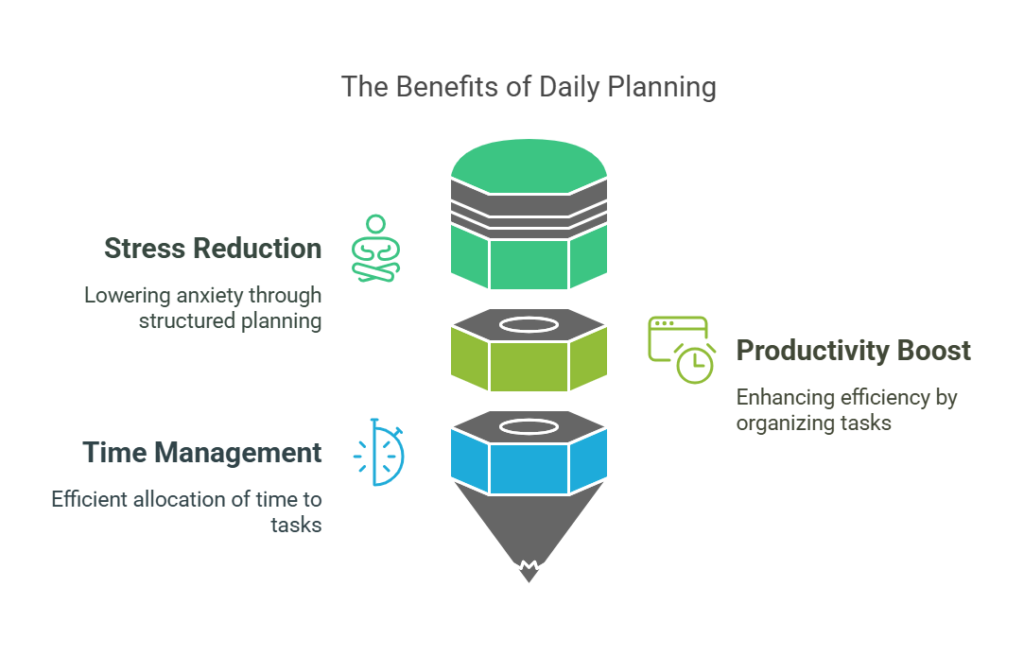
Research even backs this up: Planning your day in advance reduces stress and boosts productivity (Harvard Business Review). It’s like meal prepping for your time—once it’s done, you don’t have to think about it.
It’s Flexible Enough for Reactive Jobs
If you work in a job where things come at you unpredictably—like customer support or account management—you might think time blocking sounds impossible. But it’s totally doable if you build in some flexibility.
Here’s an example:
- 9:00 AM – 10:00 AM: Respond to customer tickets
- 10:00 AM – 11:00 AM: Focus time for a specific project (let your team know you’re unavailable unless it’s urgent)
- 11:00 AM – 11:30 AM: Quick check for any new urgent tasks
- 11:30 AM – 12:30 PM: Work on long-term projects or admin tasks
By scheduling time for both reactive and proactive tasks, you’re staying organized while still being available for what your job demands. It’s all about balance.
Common Time Blocking Pitfalls (and How to Avoid Them)
Time blocking sounds like the ultimate solution to staying organized and productive. You make a plan, stick to it, and bam—your day is magically under control, right? Not always. The truth is, time blocking is awesome, but there are a few traps you can fall into if you’re not careful. Don’t worry, though—we’re here to talk about the common pitfalls and how you can steer clear of them.
1. Overloading Your Schedule
One of the biggest mistakes people make with time blocking is trying to pack their day tighter than a carry-on suitcase. You block every minute for some task, thinking you’ll get more done, but instead, you’re setting yourself up to feel overwhelmed and behind.
Why it doesn’t work: Studies show that we tend to overestimate how much we can accomplish in a day (Planning Fallacy, anyone?). Plus, when things inevitably take longer than expected, your whole schedule falls apart.
2. Being Too Rigid With Time Blocks
Here’s the thing: life doesn’t care about your carefully crafted schedule. Unexpected meetings, tech issues, or even just needing a break can throw your blocks off track if you’re not flexible.
Why it doesn’t work: When you’re too rigid, any tiny hiccup can make you feel like the whole day is ruined. It’s demotivating, and honestly, unnecessary.
3. Ignoring Buffer Time for Interruptions
Imagine this situation where you’ve perfectly blocked your day, but five minutes into your deep work block, you get an urgent email. Now you’re scrambling, and everything feels out of whack. Sound familiar?
Why it doesn’t work: Stuff happens. Emails, calls, or unexpected questions from coworkers are inevitable, and if you don’t plan for them, they’ll derail your schedule.
4. Failing to Account for Energy Levels and Productivity Peaks
Ever try to do your most brain-heavy work right after lunch and wonder why your brain feels like it’s running on 1% battery? That’s because our energy and focus fluctuate throughout the day.
Why it doesn’t work: Ignoring your natural energy levels means you’re fighting your own body clock. Instead of optimizing your time, you end up feeling drained and frustrated.
Pro tip: A study in Chronobiology International found that most people hit peak focus in the late morning. Use this time for your toughest tasks.
5. Neglecting Personal Time and Breaks
Raise your hand if you’ve ever scheduled your day so tightly that you forgot to eat lunch or take a breather. It’s easy to get caught up in trying to maximize productivity and completely forget about yourself.
Why it doesn’t work: Skipping breaks doesn’t just make you tired—it kills your productivity. Studies show that taking regular breaks improves focus and creativity (Harvard Business Review).
Tips for Successful Time Blocking
Time blocking is a great way to keep your day organized, but let’s be real—it’s not magic. To make it work, you need to approach it in a way that fits your life. Don’t worry, it’s easier than it sounds. Here are some simple tips to help you get started and stay on track.
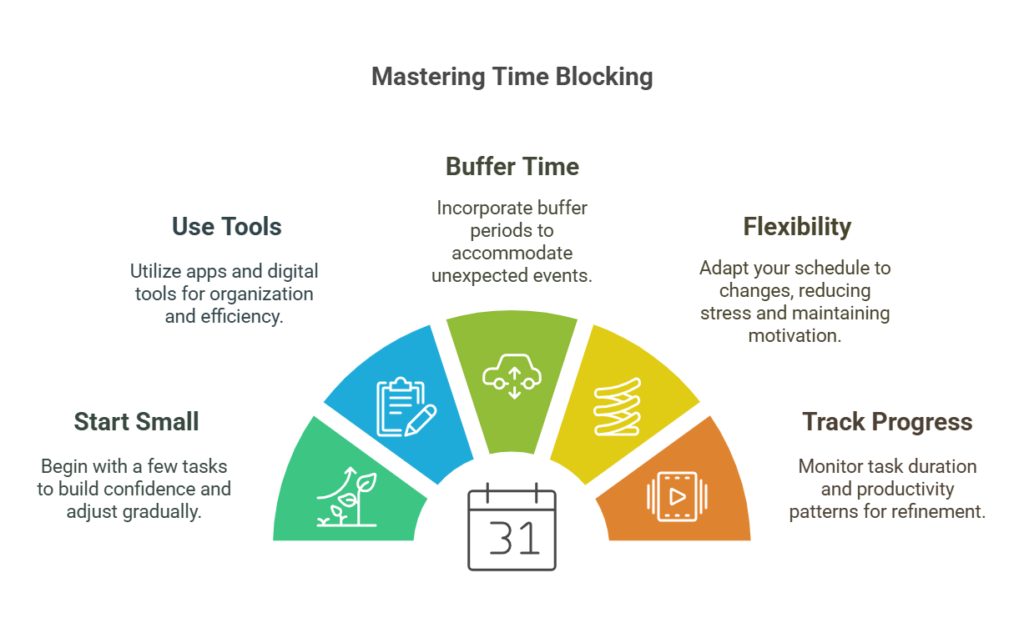
1. Start Small and Adjust as You Go
You don’t have to map out every second of your day right away. Start small—maybe block out time for just a couple of tasks, like your morning focus work and afternoon emails. See how it feels and tweak as needed.
Think of it like learning to ride a bike: training wheels first. You’ll build confidence and eventually get the hang of it.
2. Use Productivity Tools
Apps make time blocking so much easier. Whether it’s a digital calendar or a task manager, having everything in one place keeps you organized.
These tools don’t just make time blocking easier—they make it feel more fun. And who doesn’t love checking things off a digital list?
3. Schedule Buffer Time for the Unexpected
Stuff happens. Emails, calls, or random interruptions are part of life. If you pack your day too tightly, even a small delay can throw everything off.
How to handle it:
- Leave 10-15 minutes of buffer time between blocks.
- Plan a catch-up block at the end of your day for anything that ran over.
Think of buffer time like the shock absorbers on a car. It smooths out the bumps and keeps you from feeling stressed when things don’t go perfectly.
4. Be Flexible and Adapt to Changes
Life doesn’t always stick to your plan, and that’s okay. The beauty of time blocking is that it’s adaptable. If something comes up, just adjust your blocks.
Why flexibility is key:
- It’s less stressful to move things around than to feel like your whole day is ruined.
- You’ll stay motivated when you’re not stuck in a “all-or-nothing” mindset.
Think of your schedule as a guideline, not a rulebook. Adjust as needed and keep moving forward.
5. Track Your Progress and Refine Your Approach
Ever feel like certain tasks always take longer than you think? Tracking your time can help you figure out where your blocks might need adjusting.
How to do it:
- Use a journal or app to note how long tasks actually take.
- Pay attention to patterns, like when you’re most productive (e.g., mornings vs. afternoons).
Tracking helps you fine-tune your schedule so it fits your natural rhythm. It’s like tweaking a recipe until it’s just right.
6. Avoid Overscheduling Leisure Time
Here’s a pro tip: Don’t overplan your downtime. Yes, it’s good to block time for rest and hobbies, but don’t turn your leisure time into a to-do list.
How to keep it chill:
- Block general time for relaxing, like “7:00 PM – 9:00 PM: Unwind” instead of scheduling every activity.
- Leave space for spontaneity—sometimes the best moments are unplanned.
The goal is balance. You’re staying organized without sucking the fun out of your day.
Alternatives to Time Blocking
Alright, so maybe time blocking isn’t your thing. That’s cool—it’s not for everyone. But if you’re still looking for ways to stay on top of your day without feeling overwhelmed, there are other methods you can try. Let’s talk about three simple alternatives: Eat the Frog, Getting Things Done (GTD), and the Pomodoro Technique. These are easy to pick up and can help you stay organized without overcomplicating things.
1. Eat the Frog: Knock Out the Big Stuff First
“Eat the frog” might sound weird, but stick with me. It’s based on the idea that if you start your day by tackling your hardest or most important task, everything else will feel easier. The “frog” is that one thing you’ve been avoiding but know you need to do.
How it works:
- Figure out what your “frog” is—the task that will have the biggest impact.
- Do it first thing in the morning when your energy and willpower are strongest.
- Enjoy the rest of your day knowing you’ve already handled the hardest part.
2. Getting Things Done (GTD): Organize the Chaos
If your brain feels like it’s juggling 100 tasks at once, GTD might be your lifesaver. Created by productivity guru David Allen, GTD is all about getting everything out of your head and into a system so you can focus on actually doing the work.
How it works:
- Capture: Write down everything you need to do—big or small.
- Clarify: Decide what each task is. Is it actionable? Does it need to wait?
- Organize: Sort tasks into categories like “To Do,” “Waiting On,” or “Someday.”
- Reflect: Check your lists regularly to stay on track.
- Engage: Pick tasks based on priority and context.
3. Pomodoro Technique: Work in Sprints
If staying focused is a struggle, the Pomodoro Technique might be a game-changer. It’s all about breaking your work into short bursts of focus, followed by quick breaks to recharge.
How it works:
- Pick a task.
- Set a timer for 25 minutes (one Pomodoro).
- Work until the timer goes off.
- Take a 5-minute break.
- After four Pomodoros, take a longer break (15-30 minutes).
Let’s Compare
Here’s a quick breakdown of these methods:
| Method | Best For | Key Benefit |
|---|---|---|
| Eat the Frog | Procrastinators | Gets the hardest task out of the way |
| GTD | People juggling lots of tasks | Provides a clear system for organizing |
| Pomodoro | Those who struggle to focus | Keeps you productive in short bursts |
Tools and Integrations for Time Blocking
If you’ve ever tried time blocking, you know how much of a lifesaver it can be. But let’s be real—keeping up with your blocks can feel like juggling sometimes. That’s where the right tools come in. They make the whole process smoother, easier, and (dare I say?) even fun. Let’s talk about some go-to apps and how to sync everything up so your to-do list and calendar work together seamlessly.
Tools to Make Time Blocking a Breeze
Here are a few apps that can make time blocking a whole lot easier:
1. Todoist
- Why you’ll love it: It’s super easy to use. You can list out your tasks, set due dates, and even tag them with categories like “Work” or “Personal.” Plus, it syncs with most calendar apps.
- How to use it: Create labels like “Morning Tasks” or “Deep Work” so you can quickly organize your blocks.
- Best for: People who love simple, straightforward tools but still want powerful features.
2. MeisterTask
- Why you’ll love it: It’s great if you’re more of a visual person. MeisterTask uses kanban-style boards (like sticky notes you can move around) to help you organize tasks.
- How to use it: Break down a project into smaller tasks and dedicate specific blocks to clearing out your “In Progress” board.
- Best for: Visual thinkers or anyone managing multiple projects.
3. Asana
- Why you’ll love it: Asana’s timeline view is basically time blocking built right into a task manager. You can see your tasks and deadlines all mapped out.
- How to use it: Plan your projects in Asana, then sync them to your calendar for a complete view of your schedule.
- Best for: People juggling bigger projects or working in teams.
4. Google Calendar
- Why you’ll love it: It’s the OG scheduling app. You can color-code your time blocks, set reminders, and it integrates with pretty much everything.
- How to use it: Use different colors for different types of tasks (e.g., blue for work, green for personal time). You’ll instantly see where your time’s going.
- Best for: Anyone who loves keeping things simple and centralized.
How to Sync Your Task Manager With Your Calendar
The real magic happens when you get your to-do list and calendar to talk to each other. Here’s how you can set that up:
Step 1: Pick Your Tools
First, choose a task manager and a calendar app that play well together. For example:
- Todoist + Google Calendar
- Asana + Outlook
- MeisterTask + Google Calendar
Step 2: Connect the Apps
Most apps make it pretty simple to sync up:
- Todoist: Go to settings and link it to Google Calendar. Tasks with deadlines will automatically show up in your calendar.
- Asana: Use the “Sync to Calendar” option to bring your project deadlines into your calendar.
- MeisterTask: Enable the calendar feed so you can see your tasks directly in your scheduling app.
Step 3: Block Out Your Tasks
Once everything’s synced, start assigning blocks. For example:
- Drag “Finish Presentation” from Todoist into a 9:00 AM – 10:30 AM slot on your Google Calendar.
- Use Asana’s timeline view to plan your week, then match it to your calendar for a clear daily plan.
Step 4: Review and Adjust
At the end of the day, take a few minutes to see what worked and what didn’t. Move things around if needed and fine-tune your schedule for tomorrow.
Frequently Asked Questions (FAQs) About Time Blocking
Alright, let’s be real—time blocking sounds awesome in theory, but you probably have a few questions. Like, what happens when life throws curveballs? Or how do you make it work when your job feels like a constant game of whack-a-mole? Don’t worry, I’ve got you covered. Here are some common questions and answers to help you figure out if time blocking can fit into your life.
Can Time Blocking Work for Reactive Jobs?
Totally. Even if your job is full of surprises (looking at you, customer support and account managers), time blocking can still help. The key is to keep it flexible.
How Do I Handle Interruptions and Unexpected Tasks?
Interruptions happen. It’s life. The trick is to plan for them instead of letting them throw your entire day off.
What If I Don’t Finish a Task Within the Time Block?
Hey, it happens. Sometimes tasks take longer than you thought they would. The important thing is not to let it derail your whole day.
How Do I Balance Work and Personal Time With Time Blocking?
Great question. Time blocking isn’t just for work—it’s also a great way to make sure you’re prioritizing yourself and the things you care about outside of work.
Final Thoughts: Is Time Blocking Right for You?
So, is time blocking the ultimate solution to all your scheduling problems? Maybe, maybe not. Here’s the deal:

The Good Stuff:
- It keeps you organized and focused.
- You spend less time deciding what to do and more time actually doing it.
- It helps you prioritize what matters most.
The Challenges:
- It can feel a little rigid, especially if your day is unpredictable.
- It takes some trial and error to get it right.
- It requires you to stay consistent (which can be tough at first).
Time blocking isn’t about following some perfect, cookie-cutter schedule. It’s a tool to help you take control of your time and feel more organized. Start small. Maybe block a couple of hours a day to begin with, and see how it feels. Tweak it as you go. Whether you stick with time blocking or find another system, the key is to figure out what works best for you. And honestly? That’s half the fun.
List of Study & References
Psychological Review (Task Switching Productivity Loss)
- Reference: Study on how task switching reduces productivity by as much as 40%.
- Use in Article: Highlighted to show how time blocking helps focus on one task at a time, minimizing productivity loss.
- Link: Psychological Review – Task Switching and Productivity Loss
American Psychological Association (Multitasking Impact)
- Reference: Multitasking can decrease productivity by 40%.
- Use in Article: Explains why time blocking’s one-task-at-a-time approach is more effective.
- Link: APA – Multitasking Impact Study
Harvard Business Review (Regular Breaks for Focus)
- Reference: Study showing that taking regular breaks improves focus and creativity.
- Use in Article: Used to emphasize the importance of including breaks in time blocks.
- Link: Harvard Business Review – Breaks and Productivity
Journal of Experimental Psychology (Structured Schedules)
- Reference: Structured schedules reduce stress and improve focus.
- Use in Article: Supports the overall benefit of planning your day in advance with time blocking.
- Link: Journal of Experimental Psychology
Chronobiology International (Energy Peaks During the Day)
- Reference: Found that most people hit peak focus in the late morning.
- Use in Article: Encourages scheduling deep work during high-energy times.
- Link: Chronobiology International – Peak Focus Study
Journal of Personality and Social Psychology (Morning Willpower Strength)
- Reference: Willpower is strongest in the morning.
- Use in Article: Supports the idea of tackling the hardest tasks first (Eat the Frog).
- Link: Journal of Personality and Social Psychology
RescueTime Survey (Time Spent on Emails)
- Reference: Found that 26% of people spend 3-4 hours daily checking emails.
- Use in Article: Highlights how time blocking can reduce email distractions by setting specific blocks for them.
- Link: RescueTime – Email Habits Survey
Deep Work by Cal Newport (Importance of Focus)
- Reference: Time blocking helps protect deep work, which is critical for success.
- Use in Article: Builds credibility by referencing a productivity expert.
- Link: Deep Work by Cal Newport
Planning Fallacy (Overestimating Productivity)
- Reference: The tendency for people to overestimate how much they can accomplish in a given time.
- Use in Article: Demonstrates why realistic time estimates are crucial for effective time blocking.
- Link: Planning Fallacy Overview – Psychology Today
Behavior Research Methods (Task Management Systems)
- Reference: Study on how structured task management systems improve productivity and reduce stress.
- Use in Article: Supports the benefits of using tools like Todoist, Asana, or MeisterTask in time blocking.
- Link: Behavior Research Methods
Parkinson’s Law (Work Expands to Fill Time)
- Reference: The adage that work will expand to fill the time allotted for its completion.
- Use in Article: Used to explain why setting strict time limits (time boxing) prevents tasks from dragging on.
- Link: Parkinson’s Law Explained – The Economist
Journal of Experimental Psychology (Short Breaks and Focus)
- Reference: Research supporting that short breaks improve mental clarity and focus.
- Use in Article: Encourages incorporating breaks into time blocks to avoid burnout.
- Link: Journal of Experimental Psychology
Toggl and RescueTime (Time Tracking Apps)
- Reference: Tools to track how long tasks actually take to complete.
- Use in Article: Helps users refine their time estimates for better time blocking.
- Link: Toggl | RescueTime
Deep Work Principles by Cal Newport
- Reference: Emphasizes the value of uninterrupted focus for high-impact tasks.
- Use in Article: Validates the importance of scheduling deep work blocks within time blocking.
- Link: Deep Work Principles







